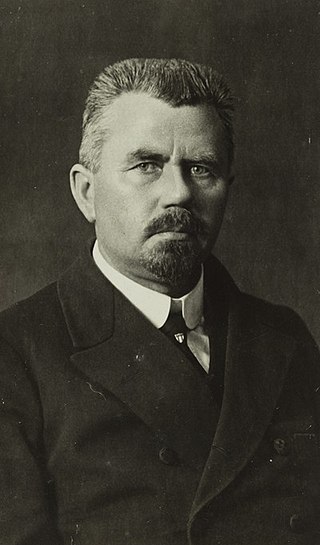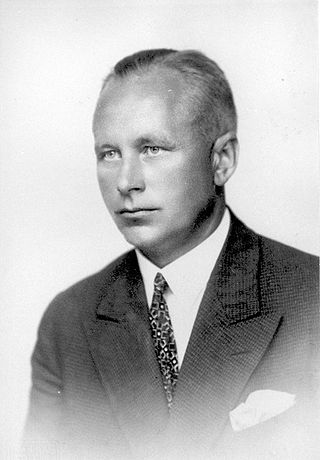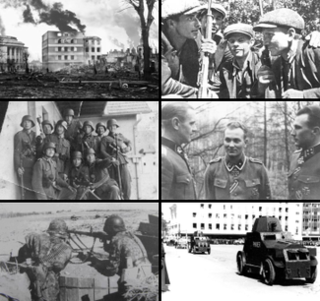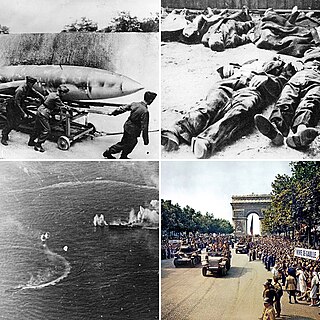| |||||
| Decades: | |||||
|---|---|---|---|---|---|
| See also: | |||||
This article lists events that occurred during 1944 in Estonia .
| |||||
| Decades: | |||||
|---|---|---|---|---|---|
| See also: | |||||
This article lists events that occurred during 1944 in Estonia .

Harju County, is one of the fifteen counties of Estonia. It is situated in Northern Estonia, on the southern coast of the Gulf of Finland, and borders Lääne-Viru County to the east, Järva County to the southeast, Rapla County to the south, and Lääne County to the southwest. The capital and largest city of Estonia, Tallinn, is situated in Harju County. Harju County is the largest county in Estonia in terms of population, as almost half (45%) of the Estonia's population lives in Harju County.

The Estonian War of Independence, also known as the Estonian Liberation War, was a defensive campaign of the Estonian Army and its allies, most notably the United Kingdom, against the Bolshevik westward offensive of 1918–1919 and the 1919 aggression of the Baltische Landeswehr. The campaign was the struggle of the newly established democratic nation of Estonia for independence in the aftermath of World War I. It resulted in a victory for Estonia and was concluded in the 1920 Treaty of Tartu.

The Battle of Narva Bridgehead was the campaign that stalled the Soviet Estonian operation in the surroundings of the town of Narva for six months. It was the first phase of the Battle of Narva campaign fought at the Eastern Front during World War II, the second phase being the Battle of Tannenberg Line.

The Battle of Narva was a World War II military campaign, lasting from 2 February to 10 August 1944, in which the German Army Detachment "Narwa" and the Soviet Leningrad Front fought for possession of the strategically important Narva Isthmus.

The Battle of Tannenberg Line or the Battle of the Blue Hills was a military engagement between the German Army Detachment Narwa and the Soviet Leningrad Front. They fought for the strategically important Narva Isthmus from 25 July–10 August 1944. The battle was fought on the Eastern Front during World War II. The strategic aim of the Soviet Estonian Operation was to reoccupy Estonia as a favorable base for the invasions of Finland and East Prussia. Waffen-SS forces included 24 volunteer infantry battalions from the SS Division Nordland, the SS Division Langemarck, the SS Division Nederland, and the Walloon Legion. Roughly half of the infantry consisted of the personnel of the 20th Waffen Grenadier Division of the SS. The German force of 22,250 men held off 136,830 Soviet troops. As the Soviet forces were constantly reinforced, their overall casualties are estimated by Estonian historian Mart Laar to be 170,000 dead and wounded.

Jüri Uluots was an Estonian prime minister, journalist, prominent attorney and distinguished Professor and Dean of the Faculty of Law at the University of Tartu.
The Estonian resistance movement was an underground movement to resist the occupation of Estonia by Nazi Germany, 1941–1944 during World War II. Due to the unusually benign measures implemented in Estonia by the German occupation authorities, especially in contrast to the preceding harsh Soviet occupation of Estonia (1940–1941), the movement was slower to develop effective tactics on a wide scale than in other occupied countries.

During World War II, in the course of Operation Barbarossa, Nazi Germany invaded Estonia in July–December 1941, and occupied the country until 1944. Estonia had gained independence in 1918 from the then warring German and Russian Empires. However, in the wake of the August 1939 Nazi-Soviet Pact, the Stalinist Soviet Union had invaded and occupied Estonia in June 1940, and the country was formally annexed into the USSR in August 1940.

Johan Pitka, VR I/1, was an Estonian entrepreneur, sea captain and a rear admiral (1919). He was the Commander of the Estonian Navy in the Estonian War of Independence.

Otto Tief was an Estonian politician, military commander, and a lawyer.

The Estonian government-in-exile was the formally declared governmental authority of the Republic of Estonia in exile, existing from 1944 until the reestablishment of Estonian sovereignty over Estonian territory in 1991. It traced its legitimacy through constitutional succession to the last Estonian government in power prior to the June 1940 Soviet invasion and occupation of the country. During its existence, it was the internationally recognized government of Estonia.

Estonia declared neutrality at the outbreak of World War II (1939–1945), but the country was repeatedly contested, invaded and occupied, first by the Stalinist Soviet Union in 1940, then by Nazi Germany in 1941, and ultimately reinvaded and reoccupied in 1944 by the Soviet Union.

This is a timeline of events that occurred during 1944 in World War II.
The Tallinn offensive was a strategic offensive by the Red Army's 2nd Shock and 8th armies and the Baltic Fleet against the German Army Detachment Narwa and Estonian units in mainland Estonia on the Eastern Front of World War II on 17–26 September 1944. Its German counterpart was the abandonment of the Estonian territory in a retreat codenamed Operation Aster.

The following is an alphabetical list of articles related to the Republic of Estonia.

The National Committee of the Republic of Estonia was a deliberative and legislative body, formed by the government of Republic of Estonia to control the resistance movement in German-occupied Estonia in March 1944. By April 1944 a large number of the committee members were arrested by the German security agencies. On September 20th, 1944, the Committee proclaimed the Republic of Estonia restored, but two days later, the Soviet Army took control of Tallinn.

This is a sub-article to Battle of Narva (1944).

The Soviet Union (USSR) occupied most of the territory of the Baltic states in its 1944 Baltic Offensive during World War II. The Red Army regained control over the three Baltic capitals and encircled retreating Wehrmacht and Latvian forces in the Courland Pocket where they held out until the final German surrender at the end of the war.

Metsakalmistu is a cemetery in the Pirita district of Tallinn.
Helle-Reet Helenurm was an Estonian actress whose career began in 1968 in theatre. She also performed as a radio, television, and film actress until her death, aged 59, of cancer.